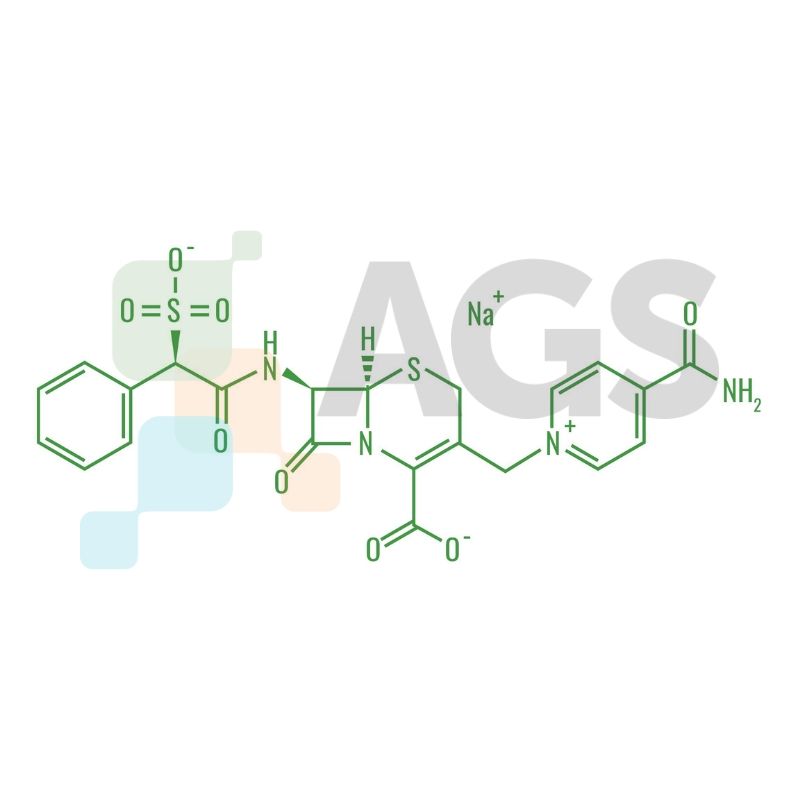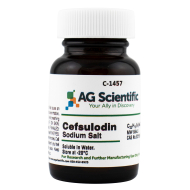Cefsulodin is a semi-synthetic third generation cephalosporin antibiotic with a structure similar to penicillins and beta-lactams. Cefsulodin is used by the water and dairy industries to test the quality of their products. AG Scientific continues to provide top quality testing reagents and supplies to water and dairy producers around the world. Here we review some of the most frequently asked questions about Cefsulodin Sodium.

Are there alternative names for cefsulodin sodium salt?
Synonyms include cefsulodin monosodium salt, sulcephalosporin, Abbott 46811, CGP-7174/E, SCE-129, Cefomonil, Monaspor, Pseudomonil, Pseudocef, Pyocefal, Takesulin, and Tilmapor.What is the chemical formula of cefsulodin sodium salt?
C22H19N4NaO8S2What is the molecular weight?
554.5 g/molWhat does it look like?
White to light yellow, crystalline powderHow pure is AG Scientific's cefsulodin sodium salt?
≥98.0%Is cefsulodin soluble?
Yes, it is soluble in ethanol and water.What is its melting point?
175°CWhat is the range of cefsulodin activity?
Cefsulodin has very specific activity against Pseudomonas aeruginosa but no significant activity against other Gram-negative bacteria and very limited activity against Gram- positive and anaerobic bacteria.What is the mechanism of action?
Like beta-lactams, cephalosporins interfere with PBP (penicillin binding protein) activity involved in the final phase of peptidoglycan synthesis. PBPs are enzymes which catalyze a pentaglycine cross link between alanine and lysine residues providing additional strength to the cell wall. Without a pentaglycine cross link, the integrity of the cell wall is severely compromised and ultimately leads to cell lysis and death. Resistance to cephalosporins is commonly due to cells containing plasmid-encoded beta-lactamases.What is the clinical application of cefsulodin sodium salt?
Cefsulodin Sodium Salt is a useful drug in the treatment of surgical infections caused by Pseudomonas aeruginosa.What are the laboratory applications of cefsulodin sodium salt?
Cefsulodin sodium is commonly used in clinical in vitro microbiological antibiotic susceptibility testing (panels, discs, and MIC strips) primarily against Pseudomonas aeruginosa isolates. Clinically, AST results are used to recommend antibiotic treatment options for infected patients.How should cefsulodin sodium salt be stored and handled?
Store at 2-8°C. For long term, store at -20°C. Keep container tightly closed and in a well-ventilated area. Use only in an area with appropriate exhaust ventilation. Keep away from heat and source of ignition. Empty containers that pose a fire risk, evaporate residue under a fume hood. Ground all equipment containing material. Do not breathe the dust.How is cefsulodin sodium used in water testing?
Water testing is done using the MI agar membrane filtration method. Cefsulodin sodium salt is the antibiotic added to MI agar as a contamination control that inhibits the growth of non-target bacteria. MI agar membrane filtration allows the simultaneous detection of Total Coliforms (TC) and Escherichia coli (E. coli) on one medium. Two enzyme substrates are included in MI medium. Fluorogen reacts with the enzyme found in total coliforms (galactosidase), and a chromogen reacts with an enzyme found in E. coli (glucuronidase). Cefsulodin is added to MI medium to inhibit non-target growth. After 24 hours of incubation at 35°C, total coliform colonies glow under a long-wave ultraviolet light (366 nanometers), and E. coli colonies appear blue under natural light.What is CIN?
Cefsulodin Irgasan Novobiocin (CIN) agar that has been formulated for the detection of Yersinia enterocolitica. Yersinia enterocolitica is a significant food or water borne enteric pathogen. It is an agent of gastrointestinal infections that invades the intestinal mucosa and lymph nodes. Infections usually lead to mild self-limiting entero-colitis or terminal ileitis in humans.The properties of CIN medium are based on selective chemical agents, antibiotics, dyes, and the basal medium. It is highly selective against the growth of Escherichia coli, Klebsiella pneumoniae, Proteus mirabilis, Pseudomonas aeruginosa, Salmonella typhimurium, Shigella sonnei and Streptococcus faecalis. CIN has been shown to be more specific than other conventional selective agars, such as Salmonella-Shigella (SS), MacConkey (MAC), Cellobiose-Arginine-Lysine (CAL), pectin agars, and other lactose-containing media, for the differentiation of Yersinia species from contaminating bacteria.
